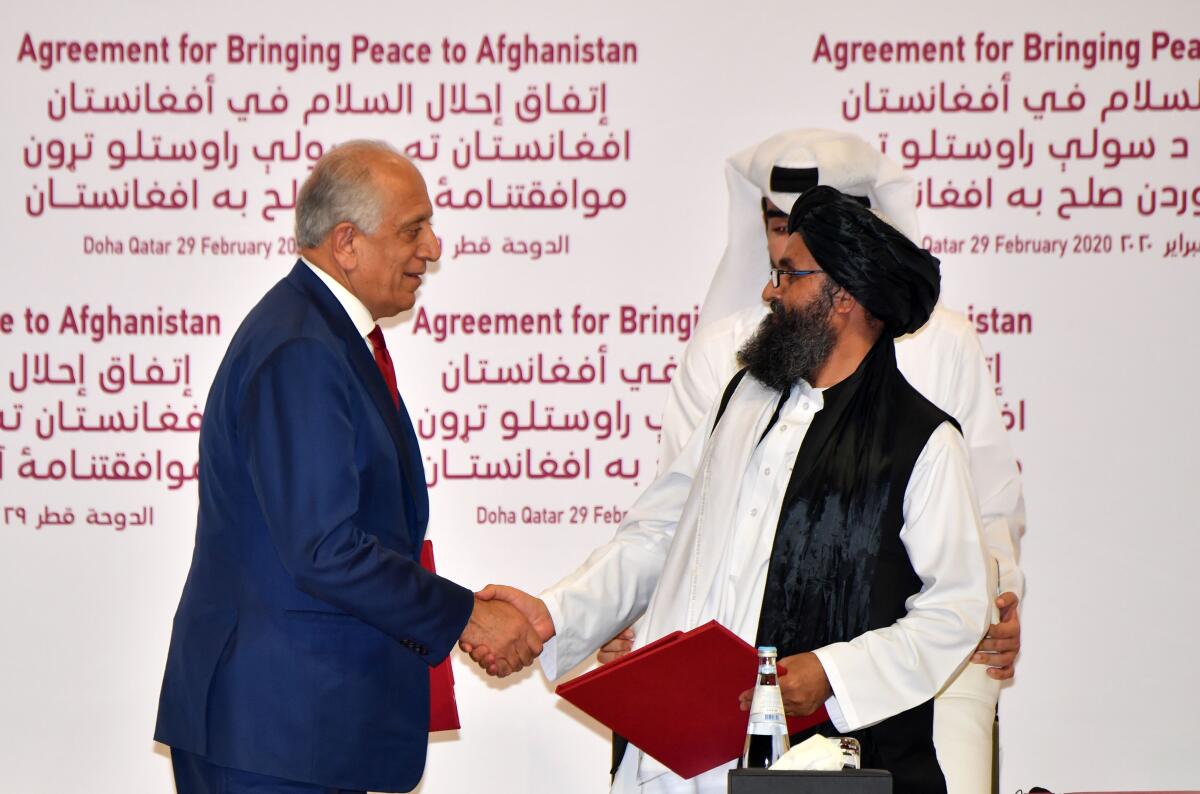A Taliban peace deal at what cost?

- Share via
Over the last year, Afghans watched as the Trump administration negotiated with the Taliban, while excluding the Afghan government, the people, civil society and, in particular, Afghan women.
The sequencing and opaqueness of this process raised alarm bells from the start, but many in the international community trusted that any deal the U.S. signed with the Taliban would not reignite another cycle of violence or a return to the severe human rights abuses and oppression of women that previously occurred under Taliban rule.
That was before we saw the terms of the deal. It’s now clear that the plan contains no meaningful provision for the protection of women and the constitutional rights that underline it. It doesn’t condition the pullout of U.S. troops on a permanent ceasefire or a successful intra-Afghan agreement. It does, however, call for the release of 5,000 Taliban prisoners before peace talks between the Afghan government and the Taliban begin on March 10, undercutting any leverage the government might have. Not surprisingly, President Ashraf Ghani of Afghanistan has said that’s not a promise the U.S. can make and that it won’t happen before negotiations start.
On Monday, the Taliban indicated that it would return to fighting against the Afghan government. Unless the talks can be recalibrated, the opportunity for peace will be squandered. The current process, which began without the inclusion of women or their elected government, has, in fact, put all the progress made in Afghanistan at risk.
Over the last 18 years, Afghans have worked hard to build their political, social and economic institutions. Although serious challenges remain in consolidating these gains, the recent Asia Foundation Survey of the Afghan People shows that 65% of Afghans trust the way in which their democracy works. In sharp contrast, only 6% strongly sympathize with the Taliban’s political project.
In the past two decades, Afghan girls and women have experienced remarkable change. In 2001, only 500,000 boys attended school. Today, 9 million boys and girls are being educated. Women went from being virtually erased under Taliban rule to becoming policewomen, teachers, public officials, mayors and entrepreneurs. In 2019, women accounted for 28% of the Afghan parliament — a proportion higher than 67% of countries tracked by the World Bank. They will not go back.
The majority of Afghan citizens stand behind them: 65% of citizens say they are not willing to sacrifice women’s education or their right to work outside their home. They also want a strong central government to protect these rights.
But these principles were apparently ignored by the American and Taliban negotiators. President Trump wants to end the war, and most Afghans don’t want a permanent presence of foreign troops. But it’s far from clear if the deal can create the conditions for a real peace — or if it’s largely a road map for an American exit.
Much of the fear and uncertainty felt across the country was heightened by a process that was secretive and exclusive, one that raised the specter of an interim government, threatening the country’s hard-won democratic institutions. If the government’s talks with the Taliban fail, it would be wrong to blame the Afghan people when they and the government were actively excluded from the process that set this stage.
The way forward will require broad political support from all of Afghan society. Only a democratically elected government will be able to carry out the concessions that will be needed, whether it’s releasing prisoners, reforming the armed forces, or protecting refugees or former fighters as they return to their homes.
To achieve any form of lasting stability, it is imperative that women be included at the negotiating table. For its part, the Taliban must also provide a seat for women on its side of the table. Inclusivity means involving those with the most at stake in the process.
It’s also important to reconcile the Taliban to the changes that have occurred in Afghan society over the past two decades. Taliban leaders must understand the financial and political consequences of their positions. Over the last year, the U.S.-Taliban talks have been predicated on the idea that the Taliban has changed. The Taliban will have to demonstrate that change through actions, not merely promises without practical guarantees.
The international community must also play its part to ensure that the terms of any agreement actually sustain peace and represent the will of the Afghan people. The deputy leader of the Taliban, Sirajuddin Haqqani, has said that Afghanistan will need continued development assistance from the international community. If the U.S., the European Union and others are to continue to invest in Afghanistan’s development and institutions, they must ensure that progress on women’s rights is not rolled back and the constitutional order is preserved.
This is a historic moment that could bring an end to nearly two decades of war. But peace can’t be achieved unless the voices of Afghan women and civil society leaders are central to the talks. We should listen to them.
Staffan De Mistura is a former United Nations under-secretary-general and U.N. special envoy for Syria, Afghanistan, Iraq and Lebanon. Margot Wallström is a former foreign minister and deputy prime minister of Sweden. Sahar Halaimzai, an Afghan-British human rights advocate, currently leads the Afghan campaign Time4RealPeace.
More to Read
A cure for the common opinion
Get thought-provoking perspectives with our weekly newsletter.
You may occasionally receive promotional content from the Los Angeles Times.









